Bathtub
How to Unclog a Bathtub Full of Water
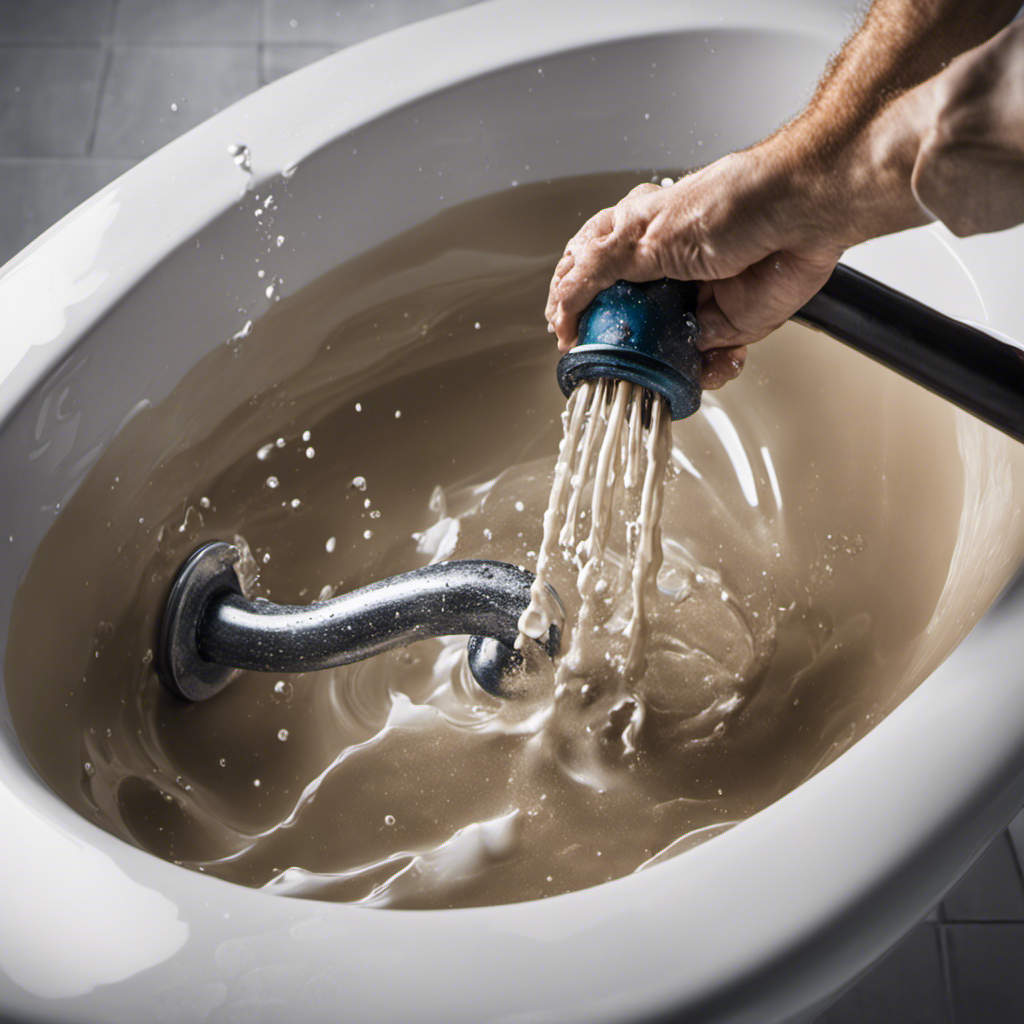
Are you tired of dealing with a bathtub full of water that just won’t drain? Well, you’re in luck! In this article, we’re going to show you step-by-step instructions on how to unclog your bathtub using simple tools and techniques.
So, roll up your sleeves and get ready to tackle that stubborn clog head-on. Say goodbye to the frustration and hello to a clear and functional bathtub drain.
Let’s get started!
Key Takeaways
- Hair accumulation, soap scum, debris, foreign objects, and grease or food particles can all cause a bathtub drain to clog.
- The necessary tools for unclogging include a plunger, drain snake, bucket, rubber gloves, and boiling water.
- Before unclogging, it’s important to remove excess water from the bathtub using a bucket and towel or sponge.
- Unclogging methods include using a plunger, employing a drain snake or auger, and seeking professional drain cleaning services for severe clogs.
Identifying the Cause of the Clog
Now that you’ve got a bathtub full of water, it’s time to figure out what’s causing the clog. Identifying the cause of the clog is crucial in order to effectively unclog your bathtub.
There are several common clog culprits that could be to blame. One possible cause is hair accumulation. Hair tends to get trapped in the drain and can quickly build up over time, leading to a blockage.
Another common cause is the accumulation of soap scum and debris. These substances can create a sticky residue that sticks to the inner walls of the pipes, causing a clog.
Additionally, foreign objects such as toys or jewelry can accidentally fall into the drain and cause a blockage.
Gathering the Necessary Tools for Unclogging
Before you start, make sure you have all the necessary tools to unclog the bathtub. Here is a step-by-step process to help you out:
- Plunger: This tool will help create pressure to dislodge the clog.
- Drain snake: A flexible cable that can reach deep into the drain and pull out the blockage.
- Bucket: To catch any water that may spill out during the unclogging process.
- Rubber gloves: Protect your hands from any potential mess.
- Hot water: Boiling water can help break down the clog.
Now that you have all the tools ready, it’s time to start the unclogging process. Remember to wear your rubber gloves before you proceed.
First, fill the bathtub with hot water to help soften the clog.
Next, use the plunger to create suction and push the clog through the drain.
If the plunger doesn’t work, try using a drain snake to remove the blockage.
Once the clog is cleared, run hot water down the drain to flush out any remaining debris.
Removing Excess Water From the Bathtub
To remove excess water from the tub, you can use a bucket to scoop it out. This step is important because it will make it easier to work on unclogging the drain.
Start by placing the bucket near the drain and slowly scoop out the water, being careful not to spill it on the floor. Once you have removed most of the water, you can use a towel or sponge to soak up any remaining moisture. This will help prevent future clogs and ensure that your bathtub is clean and ready for the next use.
Now that you have removed the excess water, you can move on to the next step of using a plunger to dislodge the clog.
Using a Plunger to Dislodge the Clog
Using a plunger is an effective way to clear the clog in the drain. When faced with a bathtub full of water and a stubborn clog, a plunger can come to the rescue. Here’s how to use it efficiently:
-
Choose the right plunger: Look for a plunger with a flat cup that can cover the drain completely.
-
Create a seal: Place the plunger over the drain and press down firmly to create a tight seal.
-
Apply pressure: Push the plunger up and down vigorously to create suction and dislodge the clog.
-
Repeat if necessary: If the clog doesn’t clear immediately, repeat the plunging process a few times.
-
Try alternative methods: If the plunger doesn’t work, you can explore other options like using a drain snake or a mixture of baking soda and vinegar.
Employing a Drain Snake or Auger
When it comes to unclogging a stubborn drain, using a drain snake can be a highly efficient method. The key advantage of a drain snake is its ability to reach deep into the pipe and break up the clog, allowing water to flow freely again.
However, it’s important to consider the pros and cons of using an auger as well, as this tool may have some limitations depending on the type of clog and the specific plumbing system.
Efficiency of Drain Snake
You’ll notice a significant improvement in the efficiency of the drain snake if you rotate it in a clockwise motion while inserting it into the clogged bathtub drain. This technique helps the snake to navigate through the debris and clear the clog more effectively.
Here are five reasons why using a drain snake is a great alternative to chemical cleaners:
- Chemical cleaners can be harmful to your health and the environment.
- Drain snakes are reusable and cost-effective.
- They can reach deeper into the drain to remove stubborn clogs.
- Drain snakes do not leave behind any residue or chemical odors.
- They provide a more thorough cleaning, preventing future clogs.
Pros and Cons of Auger
One advantage of an auger is its ability to effectively remove stubborn clogs from drains. Using an auger, also known as a drain snake, can be a great manual unclogging method for your drains. It consists of a long flexible cable with a corkscrew-like end that is inserted into the drain pipe. The auger is then rotated to break up and dislodge the clog.
One pro of using an auger is that it allows you to have control over the unclogging process. However, there are also cons to consider. Augers can be difficult to use if you are not familiar with their operation, and they may not be effective for severe clogs. In such cases, it is advisable to seek professional drain cleaning services.
Professional cleaners have the expertise and specialized equipment to tackle even the most stubborn clogs, ensuring the long-term health and efficiency of your drains.
Trying Homemade or Natural Unclogging Solutions
If you’re looking for natural solutions to unclog your bathtub drain, there are a few key points to consider.
First, you can try using vinegar and baking soda. Start by pouring half a cup of baking soda down the drain, followed by half a cup of vinegar. Let the mixture sit for about 30 minutes before rinsing it with hot water.
Another option is to use hot water and salt. Simply pour a cup of salt down the drain, followed by boiling water. Let it sit for a few minutes before running hot water down the drain again.
Lastly, you can try using a plunger and dish soap. Apply a generous amount of dish soap around the rim of the plunger and create a tight seal over the drain. Plunge vigorously for a few minutes and then flush with hot water.
Vinegar and Baking Soda
To unclog a bathtub full of water, mix vinegar and baking soda to create a fizzing reaction. This homemade solution can effectively break down clogs and clear your drain. Here’s how to do it:
-
Gather the materials:
- Vinegar (preferably white vinegar)
- Baking soda
- A measuring cup
- A funnel
- A cloth or rag
-
Measure out 1 cup of baking soda and pour it down the drain.
-
Next, pour 1 cup of vinegar down the drain using the funnel.
-
Quickly cover the drain with a cloth or rag to contain the fizzing reaction.
-
Leave the mixture to work its magic for about 30 minutes.
-
Finally, pour hot water down the drain to flush away the clog.
The vinegar’s acidic properties help to dissolve grime and buildup, while baking soda acts as a natural deodorizer and gentle abrasive. Together, they form a powerful combination for unclogging your bathtub drain.
Hot Water and Salt
Pouring hot water mixed with salt down the drain can help break down stubborn clogs and improve the flow of your drain. Here’s how you can use this method to unclog your bathtub.
-
Boil a pot of water on the stove. Make sure it’s hot but not boiling.
-
Measure half a cup of salt and pour it down the drain.
-
Slowly pour the hot water into the drain, allowing it to mix with the salt.
-
Let the mixture sit for about 15 minutes to allow the salt to dissolve and break down the clog.
-
After 15 minutes, turn on the faucet and let hot water flow down the drain for a few minutes to flush away any remaining debris.
-
To prevent future clogs, consider using a hair catcher in your drain and regularly cleaning it out.
Plunger and Dish Soap
Using a plunger and dish soap is another effective method for clearing stubborn clogs in your drain. This method combines the power of suction and the grease-cutting properties of dish soap to break up and dislodge the clog.
Here’s how to do it:
- Fill the bathtub with enough hot water to cover the plunger head.
- Add a few tablespoons of dish soap to the water.
- Place the plunger over the drain and firmly press it down to create a seal.
- Begin plunging vigorously, using an up and down motion.
- Continue plunging for several minutes, making sure to maintain a good seal.
By using this technique, the combination of the plunger’s suction and the dish soap’s ability to break down grease and grime will often be enough to clear the clog.
However, if the clog persists, you may need to try other methods, such as using vinegar or chemical drain cleaners. Remember to always use caution when handling and using chemical drain cleaners.
Using Chemical Drain Cleaners Cautiously
Be careful when handling chemical drain cleaners as they can be hazardous if not used properly. Before resorting to chemical drain cleaners, it’s important to consider using alternative drain cleaning methods.
However, if you decide to use chemical drain cleaners, follow these safety precautions. First, ensure you are in a well-ventilated area and wear protective gloves and eyewear. Carefully read and follow the instructions on the product label.
Never mix different drain cleaners or use them in combination with other chemicals. Pour the recommended amount of cleaner into the clogged drain and let it sit for the specified time. Finally, flush the drain with hot water to clear the clog.
Preventing Future Clogs and Maintaining a Clear Bathtub Drain
To maintain a clear bathtub drain and prevent future clogs, it’s important to regularly clean the drain using alternative methods. Here are five effective techniques to keep your drain healthy and clog-free:
-
Pour hot water down the drain: Boiling water helps break down and flush away any debris or residue that may be causing a clog.
-
Use a drain snake: A flexible tool designed to maneuver through pipes and remove stubborn clogs.
-
Make a DIY drain cleaner: Mix equal parts vinegar and baking soda, pour it down the drain, let it sit for 30 minutes, and then flush it with hot water.
-
Install a drain strainer: This simple device catches hair and other debris before it enters the drain, preventing clogs from forming.
-
Regular maintenance: Perform routine cleaning by using a plunger or a combination of vinegar and hot water to flush out any potential clog-causing materials.
Frequently Asked Questions
What Are Some Common Signs That Indicate a Bathtub Is Clogged?
If your bathtub is clogged, there are common signs like slow draining, standing water, and unpleasant odors. To prevent a bathtub clog, use a drain cover and avoid pouring grease or hair down the drain. If the clog persists, consider professional bathtub unclogging services.
How Long Does It Usually Take to Unclog a Bathtub Using a Plunger?
To unclog a bathtub using a plunger, begin by creating a tight seal around the drain. Push and pull the plunger vigorously for a few minutes. If the clog persists, try alternative methods like using a drain snake or chemical drain cleaner.
Can I Use a Drain Snake or Auger if I Have a Pop-Up Drain in My Bathtub?
If you have a pop-up drain in your bathtub, using a drain snake or auger might not be the best option. There are alternative methods to unclog a pop-up drain and prevent future clogs. Let’s discuss them.
Are There Any Homemade Solutions That Are Safe to Use on a Bathtub Clog?
To unclog a bathtub full of water, you can use homemade solutions that are safe and effective. Natural ingredients like baking soda, vinegar, and hot water can break down the clog without causing any damage to your bathtub.
What Are Some Common Mistakes to Avoid When Using Chemical Drain Cleaners?
Avoid common mistakes when using chemical drain cleaners. Instead, opt for safer alternatives to unclog your bathtub. Follow these step-by-step instructions to effectively remove clogs without damaging your pipes or harming the environment.
Conclusion
Congratulations! You’ve successfully unclogged your bathtub full of water. By following these simple steps, you’ve saved yourself the hassle of calling a plumber and the embarrassment of having a clogged tub.
Now, you can enjoy your relaxing baths without any worries. Remember to maintain a clear bathtub drain by practicing good habits and preventative measures.
Happy bathing!
Liam’s journey with us started as a consumer. Having faced challenges while setting up his own modern bathroom, he delved deep into research.
Recognizing his knack for simplifying complex information and his authentic writing style, we were thrilled to welcome him aboard. Liam’s articles often merge practicality with style, ensuring readers find the perfect fit for their homes. Liam is an avid hiker off-duty and often jokes about finding the best “natural toilets” Mother Earth has to offer.
Bathtub
What Makes a Toilet Less Likely to Clog

Here is what we have discovered about preventing clogged toilets:
- A good flush is key. By using proper flushing techniques, we can prevent blockages and ensure smooth operation.
- Toilet paper usage is another factor to consider. Being mindful of how much we use can make a big difference.
- Regular maintenance and cleaning also play a crucial role in preventing clogs.
- Moreover, if we avoid flushing non-flushable items and consider upgrading to a high-pressure toilet, we can further reduce the risk of clogging.
Key Takeaways
- Use the appropriate amount of water to flush waste effectively.
- Avoid flushing non-flushable items such as baby wipes, dental floss, and cotton swabs.
- Regular maintenance and cleaning of the toilet bowl, drain, and tank are essential to prevent clogs.
- Consider upgrading to a high-pressure toilet for improved flushing power and reduced likelihood of clogs.
Proper Flushing Techniques
To ensure a toilet is less likely to clog, we must use the proper flushing techniques. Water conservation during flushing plays a crucial role in preventing clogs. It’s essential to use the appropriate amount of water to flush away waste effectively without wasting excess water.
When flushing, a high water pressure is necessary to ensure efficient removal of waste from the toilet bowl. Adequate water pressure creates a strong force that helps carry away debris and prevents it from getting stuck in the drainage system. However, excessively high water pressure may lead to splashing or overflowing, which can cause clogs.
Therefore, it’s important to strike a balance between water pressure and conservation to maximize flushing efficiency while minimizing the risk of clogs.
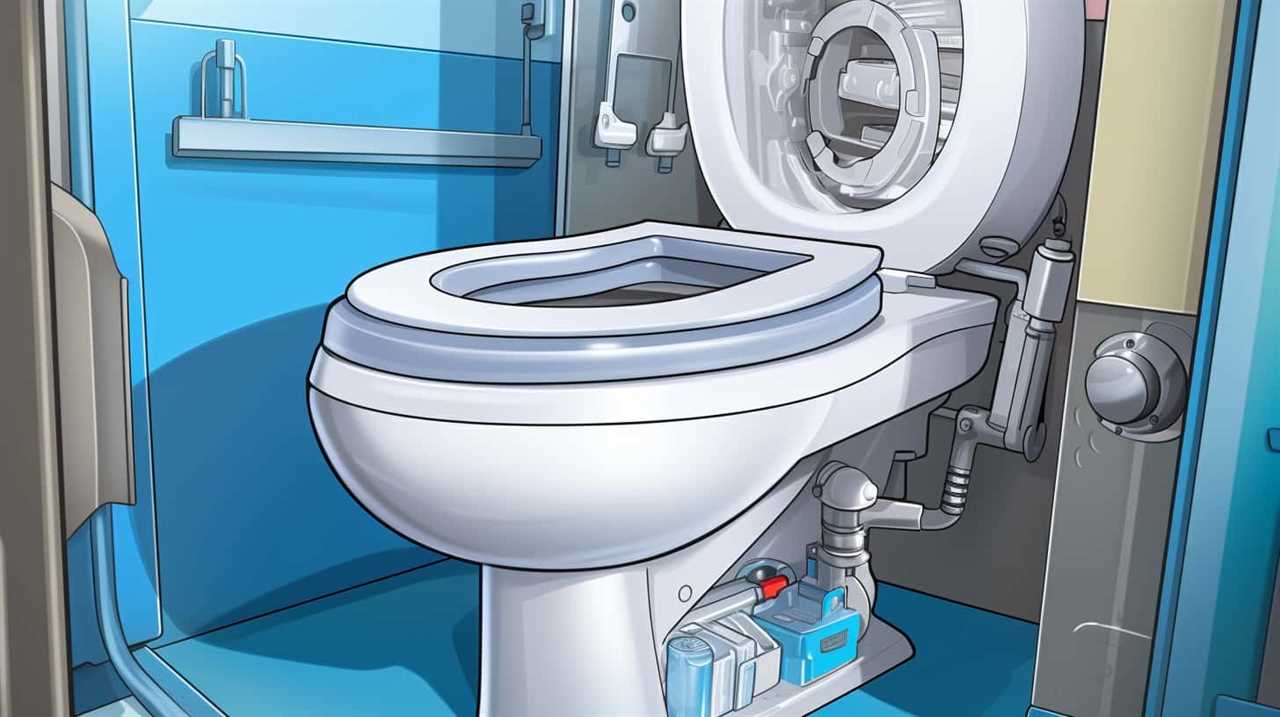
Toilet Paper Usage
When it comes to preventing clogs, our toilet paper usage is a crucial factor to consider. Not all toilet papers are created equal, and some are more prone to causing blockages than others. To help you make an informed choice, let’s analyze the environmental impact and explore alternatives to traditional toilet paper.
Toilet paper usage can have a significant environmental impact. The production of toilet paper involves cutting down trees and requires a substantial amount of water and energy. Additionally, the transportation and disposal of toilet paper contribute to carbon emissions and waste accumulation.
Considering alternatives to toilet paper can help reduce the environmental impact. Bidets, for example, provide a more hygienic and efficient way to clean oneself after using the toilet. Other options include reusable cloth wipes or bamboo-based toilet paper, which is more sustainable than traditional options.
By understanding the environmental impact of our toilet paper usage and exploring alternatives, we can make more conscious choices that are both eco-friendly and effective in preventing clogs.

Now, let’s delve into the next section about regular maintenance and cleaning.
Regular Maintenance and Cleaning
Maintaining and cleaning our toilets regularly is essential in preventing clogs and ensuring optimal performance. Neglecting this aspect of toilet care can lead to unpleasant and costly issues down the line. To keep our toilets in top shape, here are some important steps to follow:
- Toilet bowl scrubbing: Regularly scrubbing the toilet bowl removes built-up grime and prevents blockages. Use a toilet brush and a mild cleaner to thoroughly clean the bowl, paying special attention to the rim and under the rim.
- Drain inspection: Periodically inspecting the drain can help identify potential clogging issues before they become major problems. Check for any signs of blockage, such as slow draining or unusual noises. If necessary, use a plunger or a drain snake to clear any debris.
- Cleaning the tank: It’s also important to clean the toilet tank to prevent sediment buildup. Remove the tank lid and use a sponge or brush to clean the inside surfaces. Be sure to flush the tank thoroughly after cleaning.
- Regular maintenance schedule: Establish a regular maintenance schedule to ensure that cleaning and inspection tasks are performed consistently. This will help prevent clogs and maintain optimal toilet performance.
Avoiding Flushing Non-Flushable Items
One important step in preventing toilet clogs is to avoid flushing non-flushable items. Properly disposing waste and educating children about what can be flushed are crucial aspects of maintaining a functional toilet system. To emphasize the significance of this step, let’s take a look at the following table:
| Non-Flushable Items | Why They Shouldn’t Be Flushed | Proper Disposal Method |
|---|---|---|
| Baby wipes | They do not break down easily | Dispose in the trash |
| Dental floss | Can cause clogs and tangles | Throw in the trash |
| Cotton swabs | Can get stuck and form blockages | Dispose in the trash |
Disposing waste properly involves recognizing that some items, such as baby wipes, dental floss, and cotton swabs, should not be flushed down the toilet. Instead, they should be placed in the trash. Educating children about these guidelines is essential to prevent accidental flushing of non-flushable items. By following these practices, we can reduce the risk of toilet clogs and maintain a properly functioning toilet system.
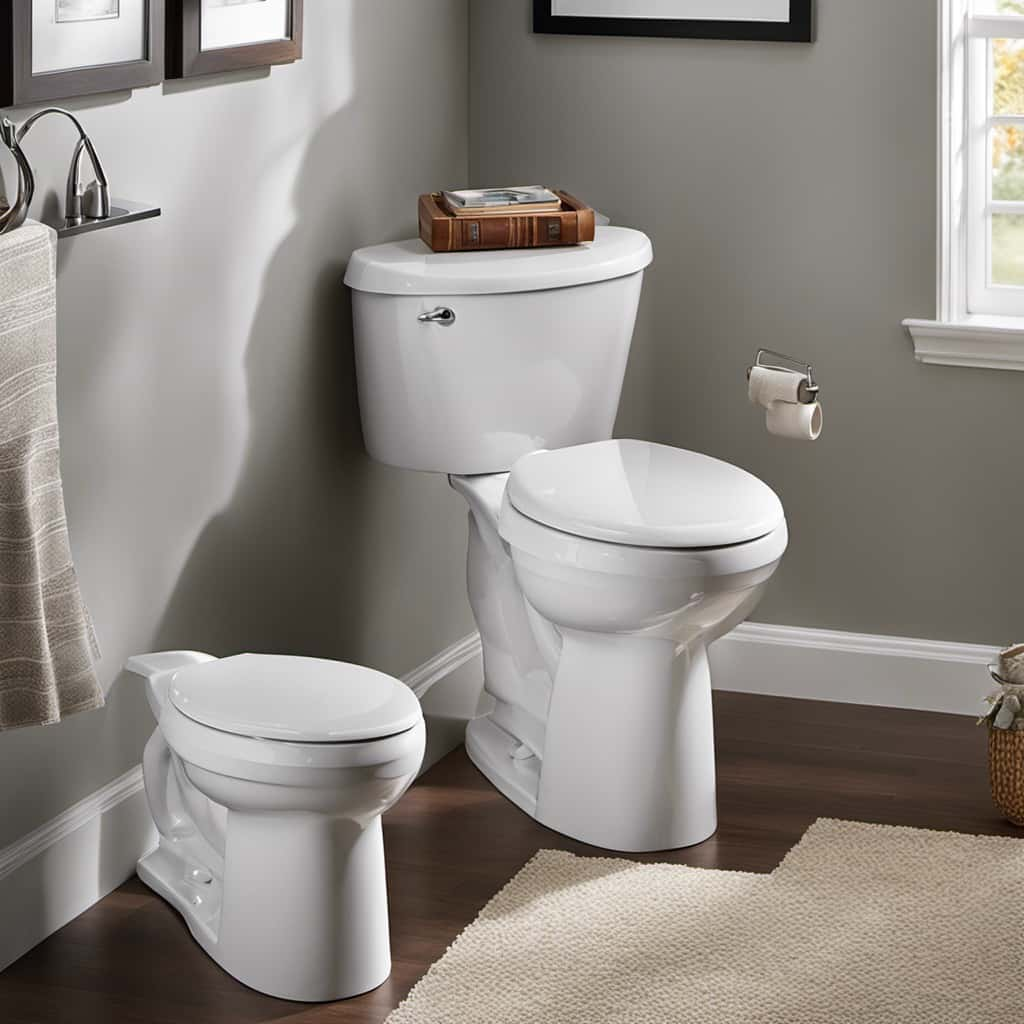
Upgrading to a High-Pressure Toilet
To reduce the likelihood of clogs, we recommend upgrading to a high-pressure toilet. High-pressure toilets are designed to provide a stronger flush, which helps to clear waste more effectively and prevent clogs from occurring.
Here are some key benefits of upgrading to a high-pressure toilet:
- Increased water pressure: High-pressure toilets are designed to operate with higher water pressure, ensuring a more forceful and thorough flush.
- Efficient waste removal: The increased water pressure helps to push waste through the plumbing system more efficiently, reducing the chances of clogs.
- Less maintenance: With a high-pressure toilet, you’ll experience fewer clogs, which means less time and money spent on maintenance and repairs.
- Improved overall performance: Upgrading to a high-pressure toilet will enhance the overall performance of your plumbing system, ensuring a more reliable and efficient flushing experience.
Frequently Asked Questions
How Do I Fix a Clogged Toilet if the Proper Flushing Techniques Mentioned in the Article Don’t Work?
If the proper flushing techniques don’t work to fix a clogged toilet, we can try other toilet unclogging techniques. One effective method is using a plunger to create suction and dislodge the blockage.
Can Using a Bidet Instead of Toilet Paper Help Prevent Clogs?
Using a bidet instead of toilet paper has several benefits, including reducing the environmental impact of toilet paper. Bidets use water to clean, which can help prevent clogs by ensuring proper flushing.

How Often Should I Hire a Professional Plumber for Regular Maintenance and Cleaning of My Toilet?
For regular maintenance and cleaning of our toilet, we should hire a professional plumber periodically. They are skilled in identifying and resolving potential issues, ensuring optimal functionality and reducing the likelihood of clogs.
What Are the Consequences of Flushing Non-Flushable Items, and How Can They Be Avoided?
Flushing non-flushable items can have serious consequences, such as clogs and damage to your plumbing system. To avoid these issues, it is crucial to educate ourselves on what can and cannot be flushed and dispose of non-flushable items properly.
Are There Any Drawbacks or Disadvantages to Upgrading to a High-Pressure Toilet?
When considering the advantages and disadvantages of upgrading to a high-pressure toilet, it is important to evaluate factors such as water consumption, noise levels, and maintenance requirements.
Conclusion
In conclusion, after investigating the truth behind what makes a toilet less likely to clog, it’s clear that proper flushing techniques, mindful toilet paper usage, regular maintenance and cleaning, avoiding flushing non-flushable items, and upgrading to a high-pressure toilet are all essential factors.

By following these guidelines, you can ensure a smoothly functioning toilet and minimize the chances of experiencing clogs. Remember, a little attention and care go a long way in maintaining a trouble-free bathroom experience.
With an impeccable eye for detail and a passion for bathroom-related, Ava leads our editorial team gracefully and precisely.
Under her guidance, Best Modern Toilet has flourished as the go-to resource for modern bathroom enthusiasts. In her free time, you might find Ava exploring antique shops and looking for vintage bathroom fixtures to add to her collection.
Bathtub
Is It Ok to Flush Condoms Down the Toilet

Let’s discuss a crucial topic: the correct way to dispose of condoms.
Flushing condoms down the toilet may seem convenient, but is it really okay? In this article, we’ll explore the potential risks and environmental impact of this practice.
We’ll also discuss the effects on plumbing systems and provide responsible alternatives for condom disposal.
Join us as we delve into this topic, aiming to inform and empower you with the knowledge you need for responsible condom use.
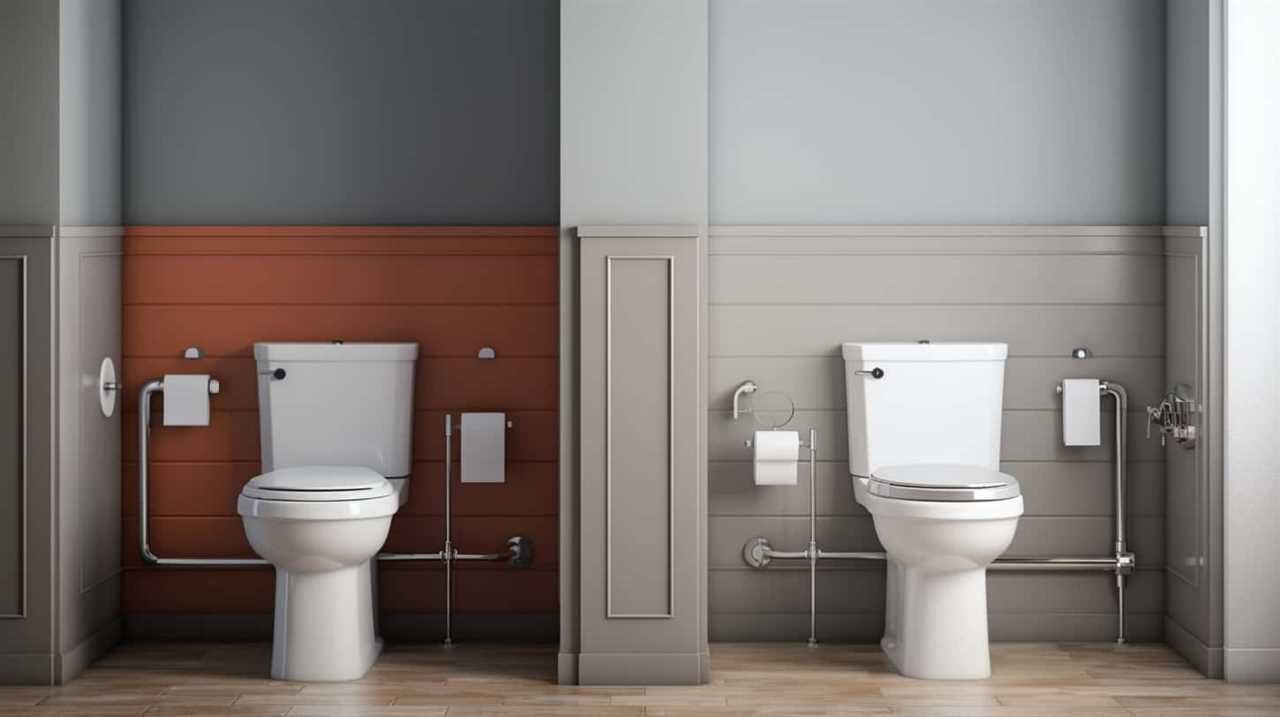
Key Takeaways
- Flushing condoms can lead to clogs and costly repairs in sewage systems.
- Flushed condoms contribute to environmental pollution in water bodies and harm marine life.
- Condoms made of latex or polyurethane are not easily biodegradable and can cause plumbing issues.
- Responsible disposal methods, such as wrapping condoms in tissue and throwing them in the trash, are essential for preventing these risks.
Potential Risks of Flushing Condoms
Flushing condoms down the toilet poses several potential risks that we should be aware of.
One of the main risks is the possibility of clogging the sewage system. Condoms are made of materials that don’t easily break down in water, such as latex or polyurethane. As a result, when flushed down the toilet, they can cause blockages in pipes and sewage treatment plants. These blockages not only disrupt the flow of wastewater, but they can also lead to costly repairs and maintenance.
Moreover, the impact on sewage systems goes beyond clogging. Condoms can end up in rivers, lakes, and oceans, contributing to environmental pollution. It’s important to properly dispose of condoms in designated waste bins to avoid these risks and protect the integrity of sewage systems.
Environmental Impact of Flushing Condoms
When condoms are flushed down the toilet, they contribute to environmental pollution by ending up in rivers, lakes, and oceans. This has significant biodegradability concerns and can have a detrimental impact on aquatic ecosystems. The materials used in condoms, such as latex and polyurethane, are not readily biodegradable and can persist in the environment for a long time. As a result, these non-biodegradable condoms can accumulate in water bodies, posing a threat to marine life. To illustrate the gravity of this issue, consider the following table:
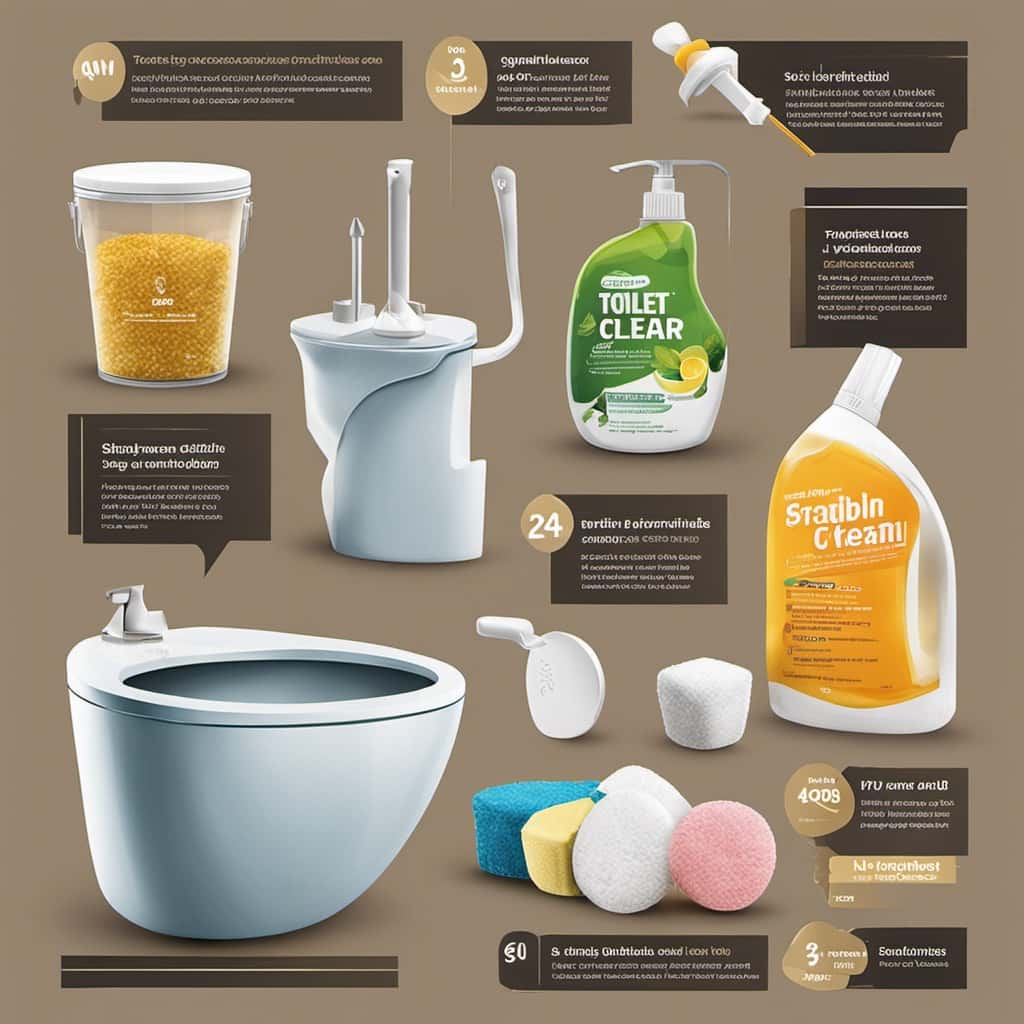
| Environmental Impact of Flushing Condoms | ||
|---|---|---|
| Condom Materials | Biodegradability | Impact on Aquatic Ecosystems |
| Latex | Not readily biodegradable | Can harm marine life |
| Polyurethane | Not readily biodegradable | Can harm marine life |
It is crucial to raise awareness about the negative consequences of flushing condoms and encourage responsible disposal methods to protect our environment.
Effects of Condoms on Plumbing Systems
As we continue our discussion on the environmental impact of flushing condoms, it’s important to consider the effects these contraceptives can have on plumbing systems.
When condoms are flushed down the toilet, they can cause various plumbing issues that may lead to clogging concerns. Condoms are made of materials like latex or polyurethane, which aren’t easily biodegradable. These materials have the potential to cause blockages in pipes, especially in older plumbing systems with narrower pipes.
Additionally, condoms can wrap around other debris in the plumbing, creating a larger obstruction. This can result in reduced water flow, backups, and even costly repairs.
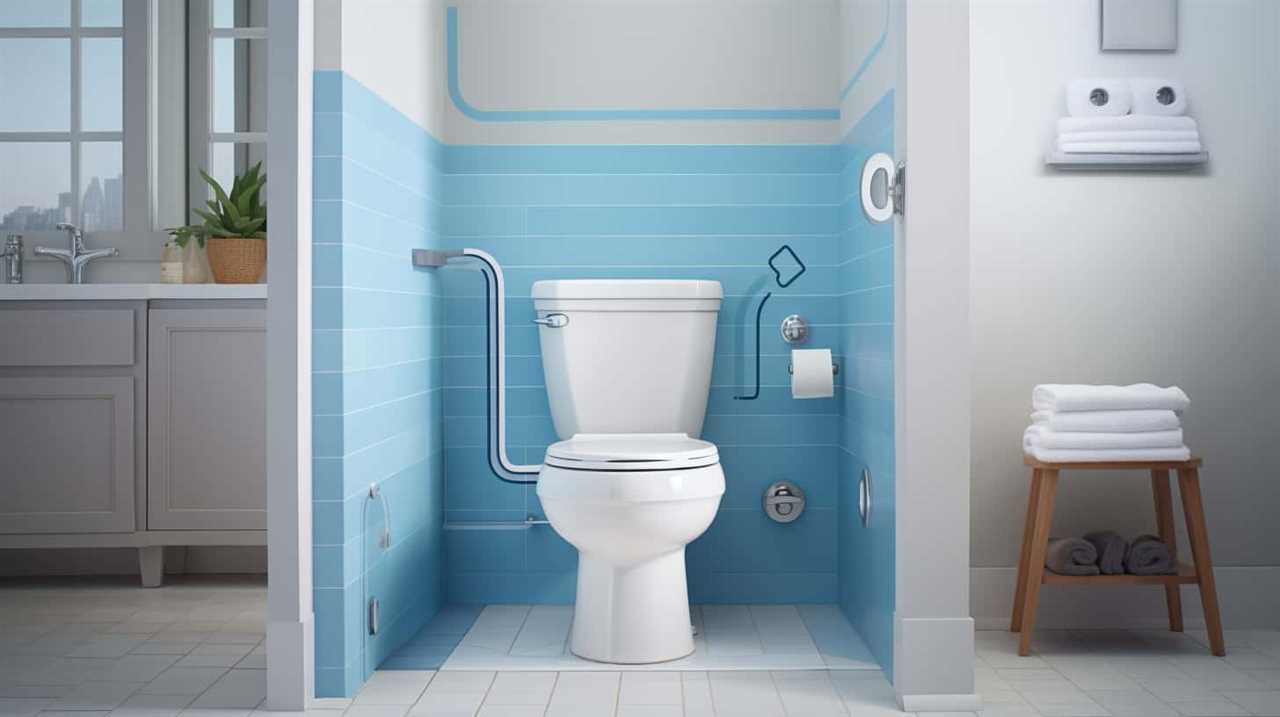
It’s crucial to dispose of condoms properly in trash bins to prevent these plumbing problems and maintain the integrity of the plumbing system.
Alternatives to Flushing Condoms
To avoid the potential plumbing issues associated with flushing condoms, we can explore alternative methods of disposal.
One sustainable condom disposal option is to wrap the used condom in tissue or toilet paper and place it in a waste bin. This prevents clogging of the plumbing system and ensures proper waste management.
Another alternative is to use biodegradable condoms. These condoms are made from materials that can break down naturally over time, reducing their environmental impact. Biodegradable condom options are becoming more widely available and offer a more eco-friendly option for disposal.

Responsible Methods of Condom Disposal
To ensure responsible condom disposal, we can continue the conversation by exploring effective methods that minimize the risk of plumbing issues and promote environmental sustainability.
Proper condom disposal is crucial to prevent blockages in plumbing systems and protect the environment.
Safe condom disposal methods involve wrapping the used condom in tissue or toilet paper and throwing it in the trash. It’s important not to flush condoms down the toilet as they can clog pipes and cause expensive damage.
Another option is to use dedicated condom disposal bags or pouches, which can be found at pharmacies or online. These bags are designed to securely hold used condoms until they can be properly disposed of in the trash.
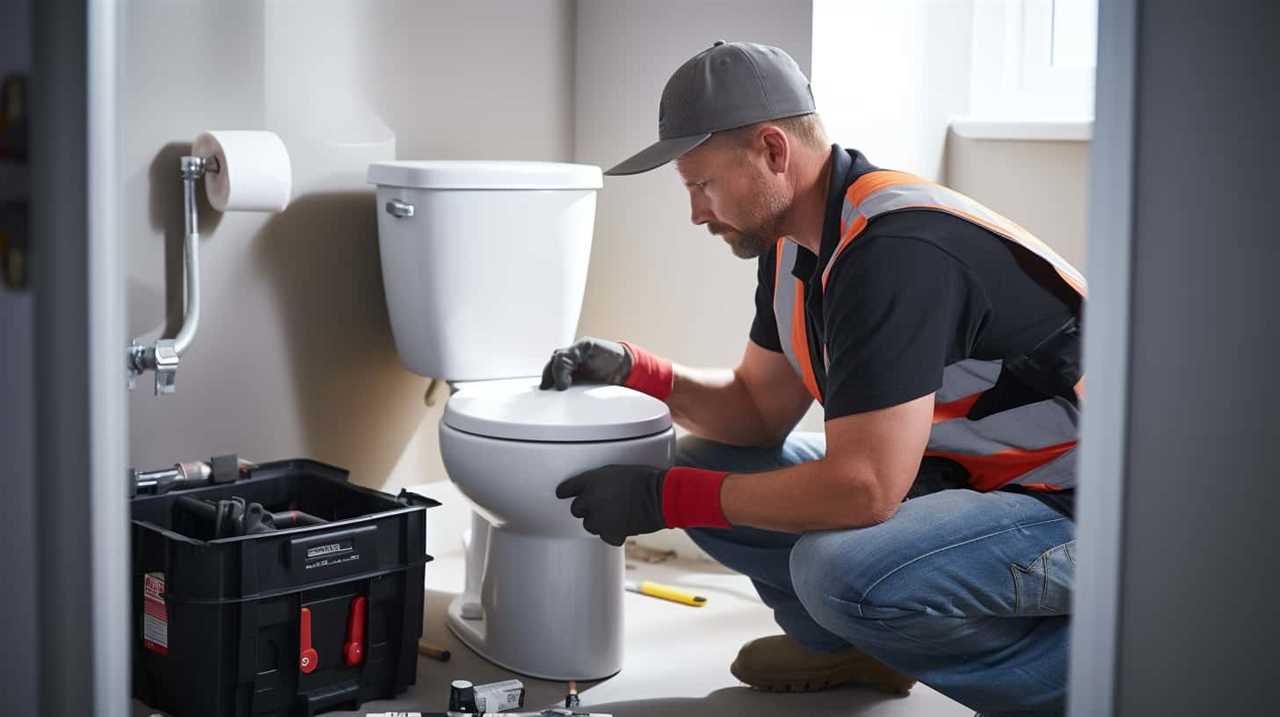
Frequently Asked Questions
Can Flushing Condoms Down the Toilet Cause Damage to the Sewage System?
Flushing condoms down the toilet can cause sewage system damage and health risks. It is important to properly dispose of condoms in the trash to prevent clogs and ensure the integrity of the sewage system.
Are There Any Health Risks Associated With Flushing Condoms?
There can be health risks associated with flushing condoms, as they can clog pipes and damage sewage systems. Proper disposal, such as wrapping them in tissue and throwing them in the trash, is recommended.
What Are the Potential Consequences of Flushing Condoms on the Environment?
Flushing condoms down the toilet can have potential pollution and environmental impact. Proper disposal is crucial to prevent clogging, sewage system damage, and harm to aquatic life. It is not recommended.
Are There Any Alternative Methods of Disposing of Condoms Besides Flushing?
When considering the proper disposal of condoms, it’s essential to explore alternative methods. Flushing condoms down the toilet may not be advisable, but there are other options available that ensure both convenience and environmental responsibility.
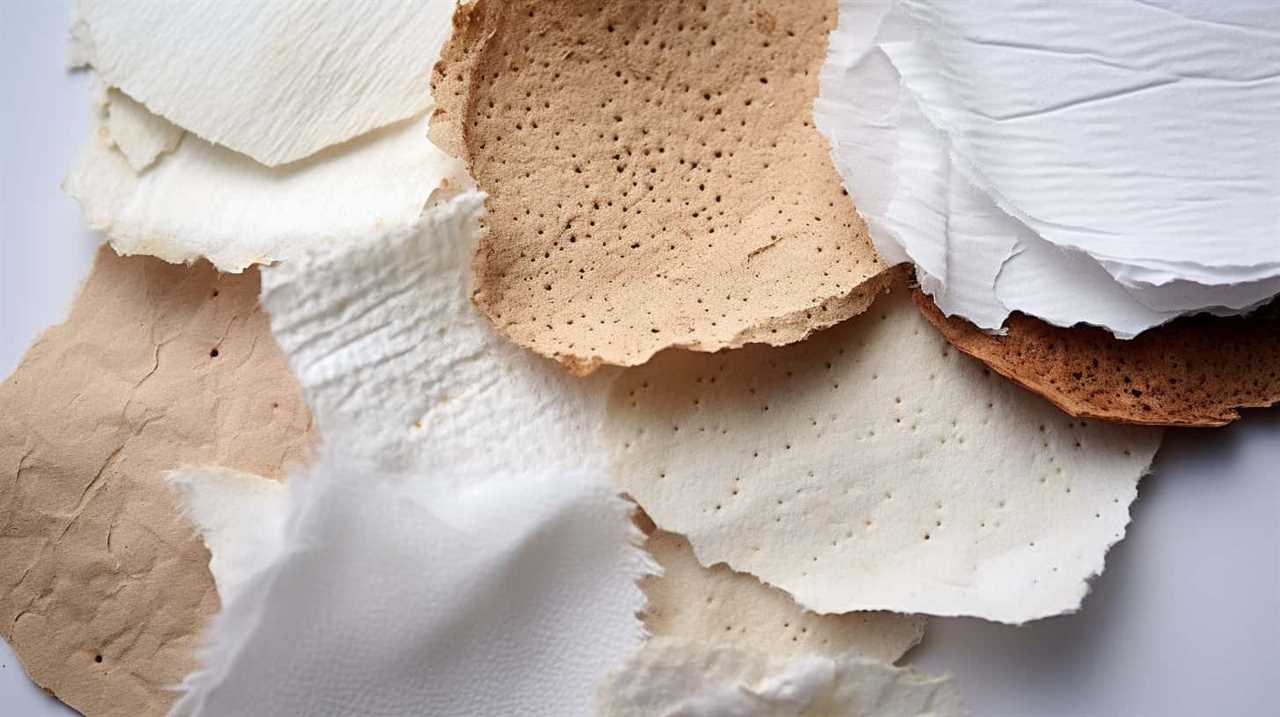
How Can Individuals Responsibly Dispose of Condoms to Minimize Their Impact on the Environment?
To minimize our impact on the environment, we must practice sustainable condom disposal. We can explore eco-friendly methods such as wrapping condoms in tissue and disposing them in the trash, or using biodegradable condom options.
Conclusion
In conclusion, it’s indeed a brilliant idea to flush condoms down the toilet! Who needs to consider the potential risks of clogged pipes, sewer backups, or the environmental impact?
Let’s just ignore the fact that condoms can wreak havoc on plumbing systems and opt for the convenient route. After all, who needs responsible methods of condom disposal when we can embrace the thrill of a plumbing disaster?
The choice is yours, but remember, sarcasm does wonders for analytical objectivity.

With an impeccable eye for detail and a passion for bathroom-related, Ava leads our editorial team gracefully and precisely.
Under her guidance, Best Modern Toilet has flourished as the go-to resource for modern bathroom enthusiasts. In her free time, you might find Ava exploring antique shops and looking for vintage bathroom fixtures to add to her collection.
Bathtub
Should I Close the Toilet Seat After Pooping
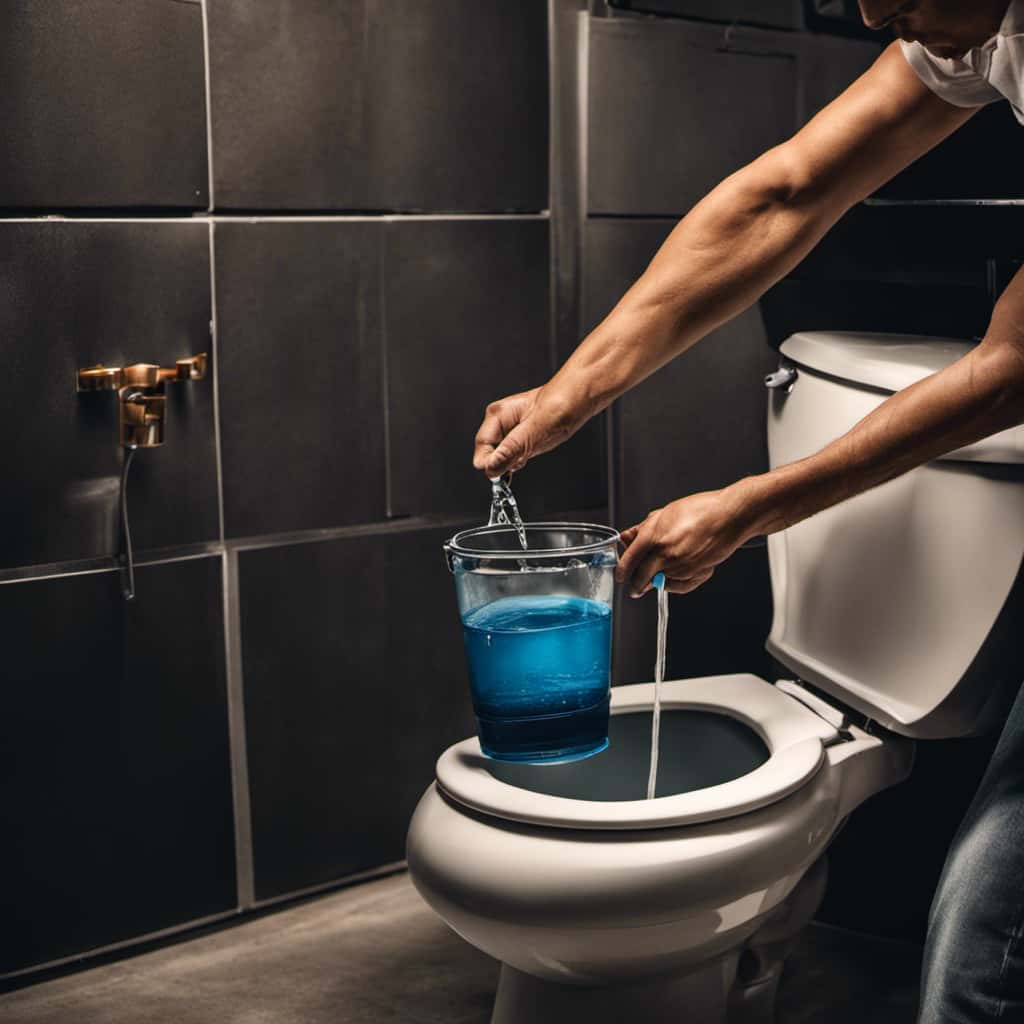
Similar to a ship’s crew discussing which way to navigate, we frequently contemplate the timeless query: should we shut the toilet seat after using it?
In this article, we explore the hygiene benefits, potential health risks, and courtesy arguments for closing the seat.
We also delve into the reasons why some opt to leave it open.
Join us as we navigate the murky waters of toilet seat etiquette and help you make an informed decision based on facts and considerations.
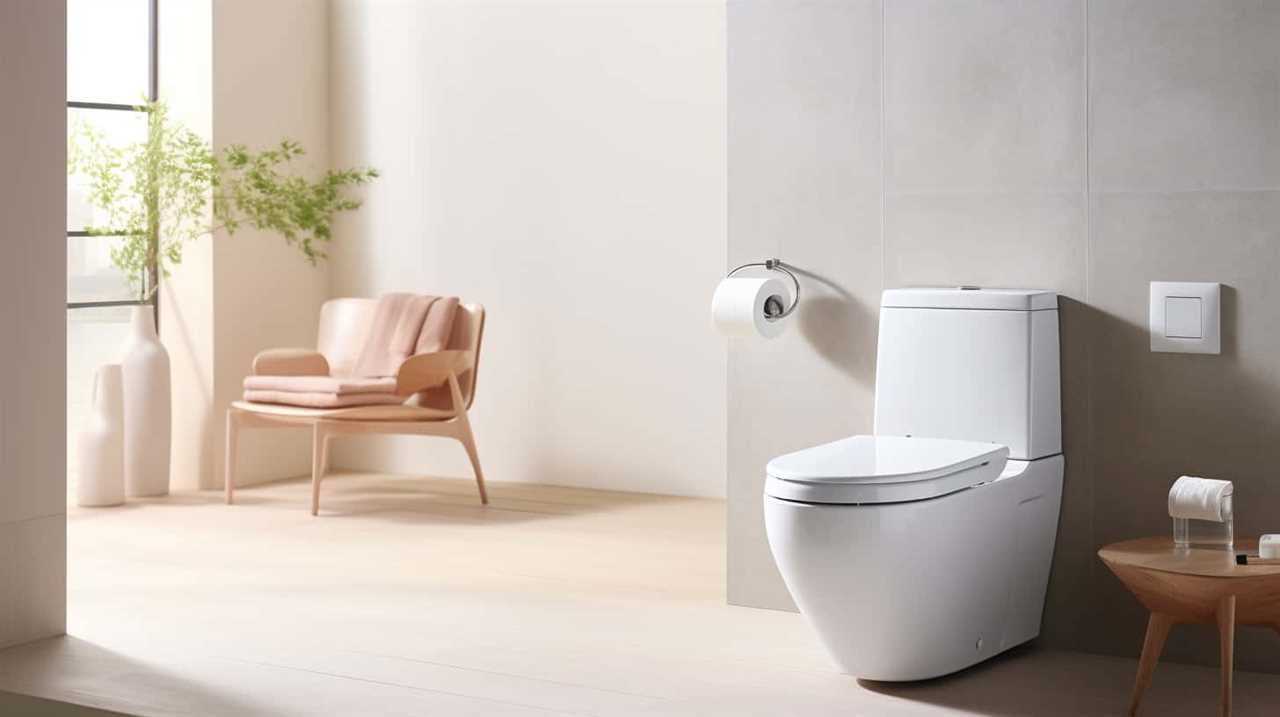
Key Takeaways
- Closing the toilet seat after pooping helps prevent the spread of germs and maintains cleanliness in the bathroom.
- Leaving the seat open increases the risk of spreading germs and bacteria throughout the bathroom, potentially causing illnesses.
- Closing the seat shows respect and consideration for others, preventing accidental contact with germs and reducing the risk of someone falling into the toilet bowl.
- When deciding whether to close the seat, it is important to consider personal preferences, household dynamics, and the importance of reaching a mutual agreement to maintain harmony in shared spaces.
Hygiene Benefits of Closing the Seat
Closing the toilet seat after using it can help prevent the spread of germs and maintain cleanliness in the bathroom. By closing the seat, you create a barrier that prevents bacteria and other microorganisms from escaping the toilet bowl and contaminating the surrounding area. This simple act of hygiene can significantly reduce the risk of illness and infection.
When the seat is left open, it allows for the dispersion of microscopic droplets that may contain harmful bacteria, increasing the chances of cross-contamination. Closing the toilet seat also prevents items from accidentally falling into the bowl, ensuring that the surface remains clean and free from potential sources of contamination.
Potential Health Risks of Leaving the Seat Open
Leaving the toilet seat open can increase the risk of spreading germs and bacteria throughout the bathroom. When the seat is left open, particles from flushing can be dispersed into the air, landing on various surfaces. These particles may contain harmful microorganisms that can cause illnesses such as diarrhea, urinary tract infections, and respiratory infections. To illustrate the potential health risks of leaving the seat open, consider the following table:
| Risks | Cleanliness |
|---|---|
| Spread of germs | Reduced hygiene |
| Increased infection | Decreased sanitation |
| Higher risk of illness | Poor bathroom hygiene |
The Courtesy Argument for Closing the Seat
After we finish using the toilet, it’s considerate to close the seat for the next person. This simple act shows respect and consideration for others who may need to use the bathroom after us. While some may argue that leaving the seat open isn’t a big deal, the courtesy argument for closing the seat holds its ground. Here are three reasons why closing the seat is the polite thing to do:
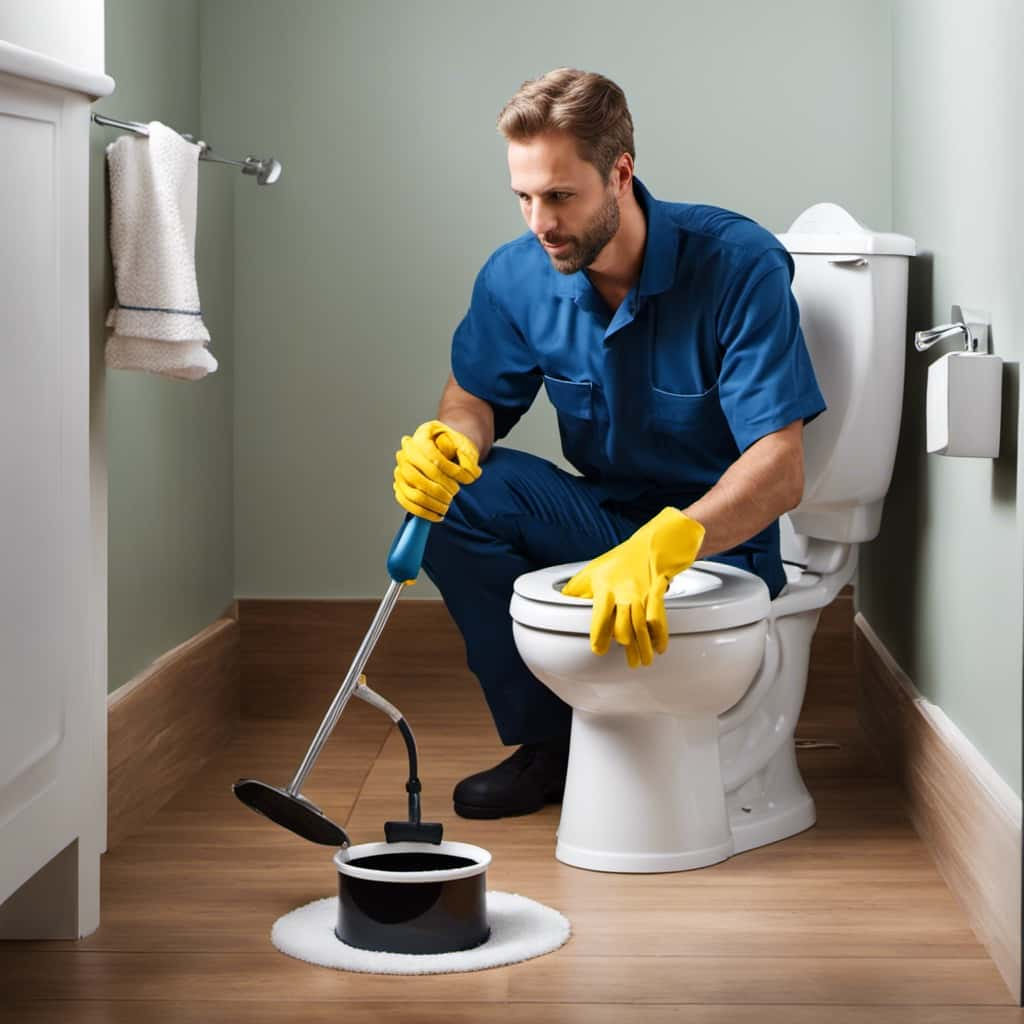
- Hygiene: Closing the seat prevents any accidental contact with germs or bacteria that may be present in the toilet bowl. It helps maintain a clean and sanitary environment for everyone.
- Safety: A closed seat reduces the risk of someone accidentally falling into the toilet bowl, especially in households with young children or elderly individuals.
- Cultural perspectives: Closing the seat is a common practice in many cultures, seen as a sign of cleanliness and respect. By adhering to this etiquette, we can show our understanding and consideration for diverse cultural norms.
Reasons Why Some People Choose to Leave the Seat Open
While it’s important to consider the courtesy argument for closing the seat, some people choose to leave it open for their own personal reasons. Toilet seat etiquette is a matter of individual preference, and there are several factors that might influence this choice.
Some individuals may have physical limitations or disabilities that make it difficult to close the seat after use. Others may find it more convenient to leave the seat open, especially in households where multiple people use the bathroom. Additionally, some individuals may have cultural or personal beliefs that affect their decision to leave the seat open.
Ultimately, each person’s choice regarding the toilet seat should be respected, as long as they’re mindful of the preferences and needs of others who share the same space.
Considerations for Making Your Own Decision
When making our own decision about whether to close the toilet seat after pooping, there are several factors to consider. Here are three key considerations to keep in mind:

- Toilet Seat Etiquette: Proper toilet seat etiquette is an important aspect to consider. Closing the toilet seat after using it shows respect for others who might use the bathroom next, ensuring a clean and tidy environment for everyone.
- Personal Preferences: Your own personal preferences should also play a role in making this decision. Some people prefer to close the toilet seat for hygienic reasons or to prevent pets from drinking out of the bowl, while others may leave it open for convenience or personal habits.
- Household Dynamics: The dynamics of your household can also influence your decision. If you live alone, you have the freedom to choose what works best for you. However, if you live with others, it’s important to consider their preferences and reach a mutual agreement to maintain harmony.
Frequently Asked Questions
Are There Any Specific Bacteria or Germs That Can Be Easily Transmitted From Leaving the Toilet Seat Open?
Leaving the toilet seat open can expose us to specific bacteria and germs that are easily transmitted. It’s important to close the toilet seat to minimize the risk of spreading these harmful microorganisms.
How Does Leaving the Toilet Seat Open Affect the Overall Cleanliness of the Bathroom?
Leaving the toilet seat open can have a negative effect on bathroom hygiene. It allows for the spread of bacteria and unpleasant odors to linger. Closing the seat after use helps maintain cleanliness and control odors.
Are There Any Potential Health Risks Associated With Closing the Toilet Seat After Pooping?
Closing the toilet seat after pooping may have potential hygiene risks. It can trap bacteria and odors, impacting bathroom sanitation. However, regularly cleaning the toilet and practicing good hand hygiene can help mitigate these risks.
What Are the Social Implications of Leaving the Toilet Seat Open in Public Restrooms?
When it comes to social etiquette in public restrooms, closing the toilet seat after use is considered good hygiene. It shows respect for others and helps maintain cleanliness, preventing potential health risks.
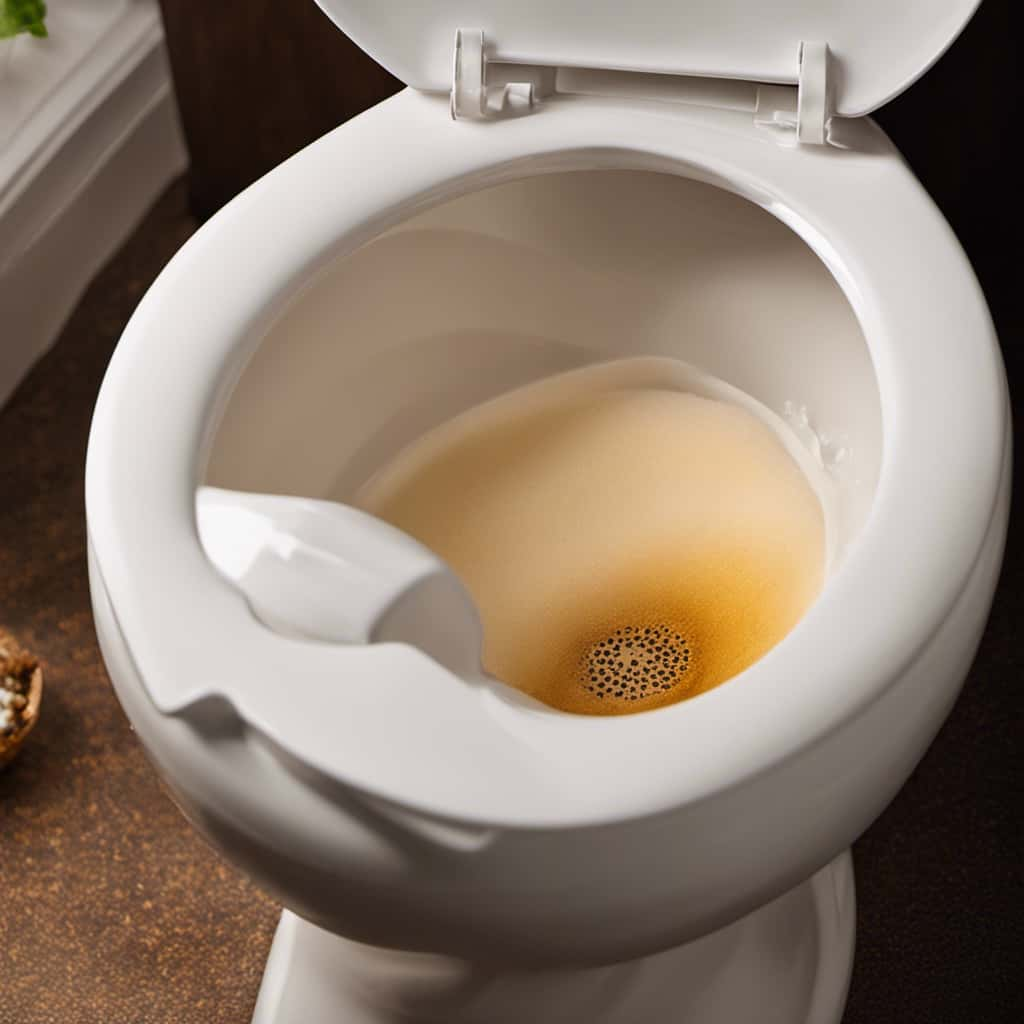
How Can Personal Preferences and Cultural Norms Influence the Decision to Close or Leave the Toilet Seat Open After Using the Bathroom?
When considering whether to close the toilet seat after using it, personal preferences and cultural norms play a significant role. Our individual choices and societal expectations shape our decision-making in this matter.
Conclusion
In conclusion, closing the toilet seat after pooping is a hygienic and considerate practice. It helps prevent the spread of germs and potential health risks associated with leaving it open.
Like closing the door to keep out unwanted guests, closing the toilet seat is a simple act of courtesy that can make a big difference in maintaining a clean and healthy bathroom environment.
So remember, just like shutting the front door to keep the cold out, close the toilet seat to keep the germs in!

With an impeccable eye for detail and a passion for bathroom-related, Ava leads our editorial team gracefully and precisely.
Under her guidance, Best Modern Toilet has flourished as the go-to resource for modern bathroom enthusiasts. In her free time, you might find Ava exploring antique shops and looking for vintage bathroom fixtures to add to her collection.
-

 Reviews3 months ago
Reviews3 months agoLDian Smart Toilet Review [2024]
-

 Bathtub1 month ago
Bathtub1 month agoAre Clorox Toilet Wand Refills Septic Safe
-

 Reviews1 month ago
Reviews1 month agoLoupusuo Luxury Smart Toilet Review [2024]
-

 Reviews1 month ago
Reviews1 month agoSimple Project Modern Smart Toilet Review [2024]
-

 FAQ - Advanced Bathroom Queries3 weeks ago
FAQ - Advanced Bathroom Queries3 weeks agoWhat to Do if You Accidentally Flush a Paper Towel
-

 Toilet Brands1 month ago
Toilet Brands1 month agoCan You Put Toilet Paper Down the Toilet in Cyprus
-

 Reviews1 month ago
Reviews1 month agoLDian Smart Toilet Review: Luxury and Hygiene Combined [2024]
-

 FAQ - Advanced Bathroom Queries1 month ago
FAQ - Advanced Bathroom Queries1 month agoWhat to Do if a Toilet Paper Roll Gets Flushed Down the Toilet






















